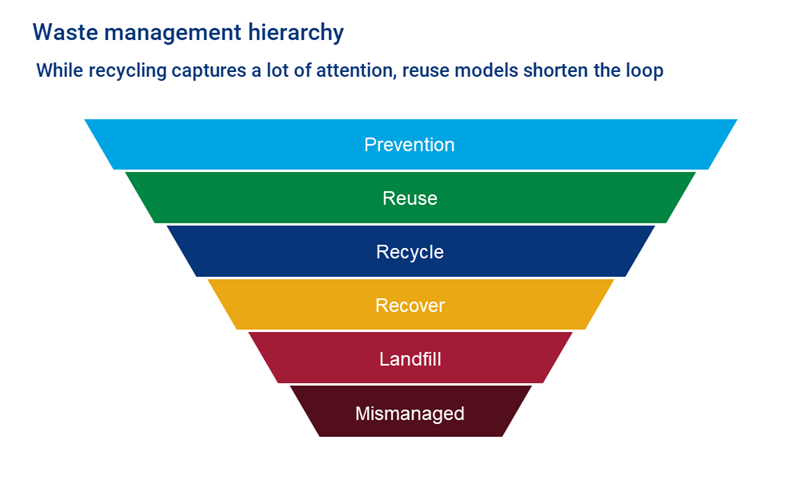How will reuse models change the plastic packaging industry?
The war on single-use plastics is pushing reuse up the agenda
1 minute read
Timur Zilbershteyn
Principal Analyst, Chemicals and Polymers

Timur Zilbershteyn
Principal Analyst, Chemicals and Polymers
Timur is a principal analyst with more than 20 years of experience in chemicals research.
Latest articles by Timur
-
Opinion
Plastic demand could reduce by up to 30% in an accelerated energy transition scenario
-
Opinion
How will reuse models change the plastic packaging industry?
Plastics have a number of desirable properties that make them suitable as packaging materials: they are versatile, durable and lightweight, have good barrier properties and are cheap. Consequently, much packaging is made of plastic, making it the world’s biggest sectoral source of plastic demand.
The problem with plastics is that they generate a lot of waste. The low cost of a plastic packaging application relative to the product it protects means that a huge proportion of packaging has traditionally been designed to be single use. But the ‘war on plastics’ is changing the industry. There is now a major focus in the packaging value chain on redesigning systems to address the issue, including the reuse of plastics.
Reuse approaches can take a number of forms, including ‘refill’ and ‘return’ models. In part three of our Chemical Solutions series, we explore the impact of these models over the next 20 years. Fill in the form for the insight preview brochure to find out more. In the meantime, read on for a brief introduction to some of the topics covered.
Reuse is a crucial (but often overlooked) component of ‘reduce, reuse, recycle’
As the world looks for alternatives to single-use plastic items, reuse models are a key tool for packaging companies.
There is a well-established hierarchy for the preferential management of waste. At the bottom of the list, the least desirable approach is mismanagement – for instance, through littering or open dumps. This causes the maximum environmental damage and the minimum retention of material value. At the other end of the spectrum, the best outcome – from a waste perspective – is for production to be prevented in its entirety.
As we work our way up the hierarchy, we minimise the waste, retain more value and reduce the amount of energy needed to bring materials back into use.
Right now, much of the debate about improving the sustainability of polymer value chains is about increasing recycling rates. Many plastic applications are damaged or contaminated after use and need to be reprocessed to bring them back into use. However, by doing away with the need to reprocess, reuse models are the more sustainable, circular solution.
A packaging value chain optimised for sustainability would, therefore, look to redesign the proportion of plastic packaging suitable for reusable applications.
Everyone needs to get on board for plastic reuse models to work
Reuse plays a marginal role in most packaging markets today. Germany is a notable exception, due to continuing obligations to use reusable or returnable single-use bottles for many types of beverages. The German Packaging Act was updated in May 2021, removing nearly all exceptions to these obligations, and mandating a re-usable alternative for packing takeaway food and drinks from 2023.
While Germany remains an outlier for now, other countries will be watching the impact of the updated Act with interest. If a success, other countries may follow suit, particularly those affected by the EU plastic tax.
Change won’t happen overnight. The penetration of reuse models will require coordination across a wide range of stakeholders. They will require the reorganisation of value chains to provide consumers with cost-effective, sustainable and, crucially, convenient packaging solutions. Logistics, technology, product design and communications all need to come together to secure market share for reuse models.
Reuse-induced polymer demand reduction could be significant
Change is underway, though, and momentum behind reuse models is growing. Companies are alert to the material and reputational benefits, and many consumer brands are experimenting with different approaches – from refillable shampoo bottles to reusable cups for takeaway coffee.
The impact will vary from market to market. Experimentation is – mostly, though not exclusively – concentrated in high-income economies right now, driven by consumer concerns, lower price sensitivity and regulatory trends. The commercialisation of these models is also likely to scale up in these markets first.
Penetration will also vary by application and polymer. Because of their high use in rigid packaging applications, polyethylene terephthalate (PET), polypropylene (PP) and polystyrene (PS) are most exposed to demand destruction from the shift to reuse models. We estimate that for select applications, polymer demand could decline by as much as 25%.
The full report explores reuse models and the impact on polymer demand in more detail. Fill in the form at the top of the page to access the preview brochure to find out more.







